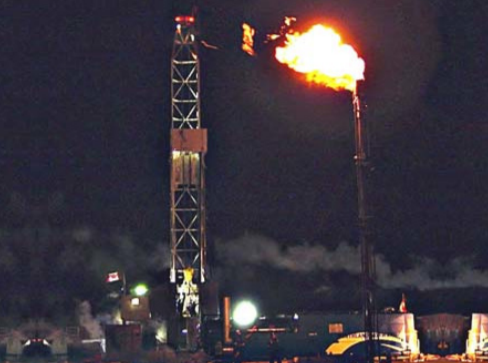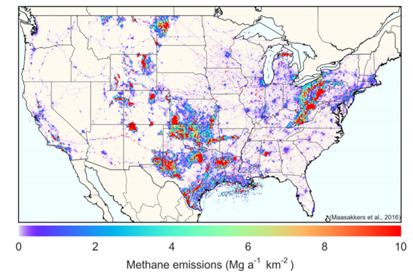Editor’s Note: In 2020 (and 2021), there have been a lot of unanswered questions about life and living, so in our partnership with the Chemical Engineering Service Learning Class at Tulane University, taught by Dr. Julie Albert, we made it our aim to find questions we could answer. The series is called “Dear Big Chem-EZ” (think “Dear Abbey” but with less about “Why does my partner ignore me?” and more about “Can I actually drink my tap water?” and “What’s that smell outside my house?”).
You can look for new pieces every day this week and next because we love science, we love answers, and we love knowing if those huge fiery balls coming out of stacks at a chemical plant that we see along the gulf coast are okay! Let’s take a look! If you have questions you’d like answered, send them to thebigchemez@gmail.com.

A natural gas flare
Dear Big Chem-EZ, around New Orleans and much of the gulf coast there are several chemical plants that I see flaring off the top of their columns. What is emitted from the flare, and is it safe for the surroundings?
Flaring, or natural gas flaring, is a controlled release of natural gas through combustion. Combustion is the burning of a fuel that creates primarily carbon dioxide and water vapor. Natural gas contains mainly methane with some other hydrocarbons and inert gases present. Flaring burns off excess or unwanted natural gas that is seen as unfit for sale due to technological or economic reasons. Natural gas is cheap relative to the other products from oil production, and the cost of processing it can often outweigh the revenue that could be made from selling it. Flaring is one of the most significant factors contributing to global carbon dioxide emissions, but flaring is more environmentally friendly than simply venting the gas into the atmosphere. (2) Flaring also can cause negative health effects to the local population, such as respiratory problems and nausea. (2) While I would not define flaring as entirely safe, it is a safer alternative to our current other options for dealing with unwanted natural gas.
Reducing natural gas flaring is of interest of industries, the government, and the population. Flaring is the single largest loss in oil production. (2) The government wants to preserve the resources present in the U.S and protect the population. Louisiana prohibits flaring except in approved cases of economic hardship. Economic hardship is defined as when the cost for delivering the gas to market outweighs the market value, so the current low market value for natural gas allows for many refineries to flare natural gas. (3) Methane emissions, including flaring, for the U.S. can be seen in the image below. (1) Louisiana has significant natural gas pipeline infrastructure, so flaring is not expected to increase to the levels seen in Texas. The population should also work to decrease flaring to protect their health and the environment.

Methane Emissions throughout the U.S including from natural gas flaring (1)
Several solutions for flare emissions have been used in industry. One of the most common routes to reduce flaring is collection and compression of the natural gas. The gas is collected, compressed, and reinjected into the system to help better process the oil. Another common route to reduce flaring emissions is using the high temperature gas to generate power by passing the gas through a turbine. Both processes help reduce the loss the company would suffer from normal flaring and decrease emissions. (2)
As we look to the future, we must work together to reduce flare emissions. While flaring is not entirely safe, it does reduce the amount of pollutants released into the environment. Reducing flare emissions will benefit the population of New Orleans by decreasing the damage caused to the environment and reducing economic losses of oil producers that employ many members of the New Orleans population.
-Big Chem-EZ
References:
 NOLAbeings
Multimedia artist Claire Bangser created NOLAbeings as a portrait-based story project that marries...
NOLAbeings
Multimedia artist Claire Bangser created NOLAbeings as a portrait-based story project that marries...
 Data corner: Adobe Suite (create a PDF, social media graphic, presentation, edit a photo and video
Data corner is where you go to work with analytics and top tech skills. It takes on everything from PERL and SQL to Canva and Sprout Social.
Data corner: Adobe Suite (create a PDF, social media graphic, presentation, edit a photo and video
Data corner is where you go to work with analytics and top tech skills. It takes on everything from PERL and SQL to Canva and Sprout Social.

[…] On the other hand, flaring is the process by which plants burn off excess hydro-carbon gases. While this process produces a large flame, Environmental Protection Agency regulations require that the flare operates at high efficiencies under complete combustion. Complete combustion means that all the waste gas is burned. This process does not produce any soot, and as a result produces no visible smoke. However, when the system experiences an upset that prevents complete combustion, the flare will produce black smoke created from the soot byproduct.(3) Although properly operated flares do not produce “smoke”, flaring is one of the largest contributors to global greenhouse gas emissions. However, the chemicals in the undesirable gas are more harmful to the environment than the products of their combustion. This means that the act of flaring is still more desirable than releasing the waste gas directly into the atmosphere.(4) For more information on flaring see the Big Chem-EZ article “Is flaring safe for the Gulf Coast?”. […]